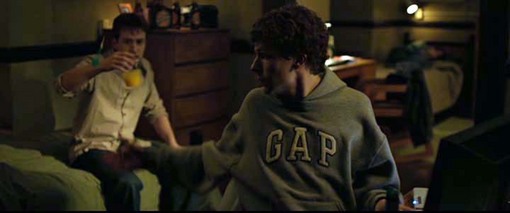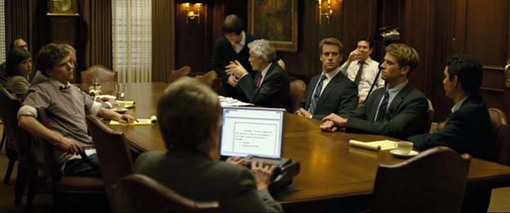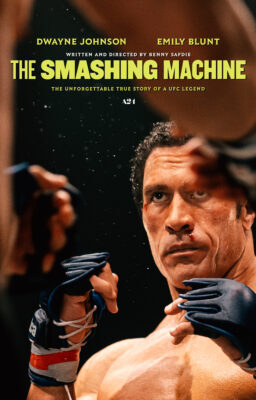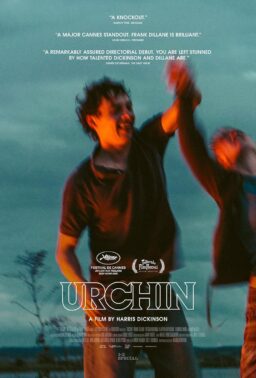Take a look at all that’s going on in the image above. Who is talking? What are the relationships between the characters? How much is packed into this one frame?
Since it came out last fall, I’d almost forgotten what an exhilarating information-overload experience David Fincher‘s “The Social Network” is. Cut and composed and performed with breathless, jittery speed, it’s a movie that consists of virtually nothing but conversations in rooms (the attempted, missed, short-circuited, coded connections that struck me when I first saw it). It’s action-packed — enough to give you whiplash, watching all the elements interacting within the 2.40:1 widescreen frame — even though there are no “action sequences” (car chases, shootouts, fist fights, acrobatic stunts, etc.); the filmmaking is charged with energy without falling back on today’s routinely frenetic, handheld run-and-gun/snatch-and-grab camerawork (the camera is generally mounted on a tripod; when it moves, it’s on a crane or a dolly — often for establishing shots or a shift in perspective that brings a new element into the frame). Smart, quick, efficient.

The crunchy guitar riff starts over the Columbia Pictures logo and then the crowd noise comes up, the music drops down, and before the logo fades to black and the first image appears, we hear Mark (Jesse Eisenberg) speaking the movie’s opening line — a question that’s also a challenge: “Did you know there are more people with genius IQs living in China than there are people of any kind living in the United States?” What follows is a blisteringly fast-paced screwball comedy exchange (“His Girl Friday” through a 64-bit dual-core processor) between Mark and his girlfriend (not for very much longer) Erica in which nearly every line is a misunderstanding (intentional or unintentional), a sarcastic jab, a leap of logic, a block, an interruption, a feint, an abrupt shift in the angle of attack, a diversion, a retreat, a refinement, a recapitulation (I’m sure there are many fencing terms that apply to the various conversational strategies employed here)…


The scene offers just a few variations on some simple camera set-ups, deployed at high speed. Erica (Rooney Mara) is always on the left, Mark on the right (even in their individual close-ups they’re slightly shifted to those positions in the frame). The cutting is as quick and nervous and aggressive as the dialog, ricocheting from volley to return (and reaction shot to reaction shot). Most edits are right at the end of each character’s lines — there are hardly any pauses between them — so that the effect is like watching an intense two-camera tennis match, cutting from one side of the net to the other.

Only once after the opening shot does Fincher offer a balanced two-shot, as Erica presents an opportunity to disarm the conversation/confrontation and take it in a neutral direction: “Should we get something to eat?” Superficially, Mark makes a similar counter-offer, but it’s really another challenge: “Would you like to talk about something else?” And then we’re back to the over-the-shoulder shots (moving into close-ups) as Erica dives back in: “No, it’s just since the beginning of the conversation about finals club I think I may have missed a birthday.” By the time Mark tries to circle back to this juncture — “Do you want to get some food?” — it’s too late to recover that balance.
It would be fun to do a line-by-line, shot-by-shot accounting of the dynamics of this scene (or this whole movie), but let’s get to the point: The style here is a modern variation on some pretty straightforward, classical Hollywood filmmaking principles, distinguished two things: the velocity at which the scene is performed and cut; and the amount of information packed into the widescreen picture. (The idea of cutting a CinemaScope picture like this — especially for a simple, two-person dialog scene — would have been unthinkable until recently. Audiences for early anamorphic pictures in the 1950s and 1960s probably would have thrown up.)


Mark and Erica appear to be the only party of two in the entire pub. And while there’s a lot of movement around them (clusters of people drinking and laughing, headless waitresses carrying baskets of food one way and another like potential peace offerings), they remain locked into position — head to head, but isolated in their separate shots. (He often looks up or down or away, as if Erica’s presence is somewhat incidental to whatever he’s talking about — something that will be overtly addressed in a later deposition scene when he deems a lawyer for the opposition to be unworthy of his full attention.)


Erica exits the frame leaving Mark alone at the table just long enough for us to register the awkwardness of the situation for him. He starts to take another sip of his beer, and then decides to just leave. Cue titles. (The fonts themselves seem to mimic the dynamics of the previous scene, with forward movement from the left blocked by the right: JESSE EISENBERG. ANDREW GARFIELD.) This is the first and last time we’ll see Mark at loose ends, out of place. He is never entirely alone (or without a network connection), and even when he’s in transit he’s seen in the context of other pedestrians on- and off-campus, streaming to their destinations like little information packets. Which is what gives the last few seconds of the film — repeated attempts to re-establish a connection from the first scene — its irony and poignance.



This sense of a private/public self is reinforced in nearly every scene, with the presence of a video camera (during the depositions), laptops and monitors, or other frames within frames (screens, windows, doorways, stairways, hallways) through which we can see other people going about their lives, doing whatever they’re doing. (The extras and bit players had a lot of work in this movie.)


And then there’s the guy in the white shirt who sits there behind the Winkelvii’s lawyer. He turns out to be the videographer, and he gets one big moment when the attorneys call “lunch” and he leaps up to turn off the camera and the monitor. We’re always reminded that what we’re seeing is being documented. Even the documentation is being documented: the affidavits that have already been filed, the e-mails and texts that were sent, the blog entries, the Harvard Crimson articles entered into evidence… Whenever Mark tries to claim he doesn’t remember what he may or may not have said to Erica or the Winkelvii (Armie Hammer), there’s always something there to remind him — often in words he typed and electronically transmitted himself.



After the opening scene, Mark has very few one-on-one conversations with anybody, except for Eduardo (notably in the cold outside the Jewish frat’s “Caribbean Night” party, and in his room), a few short exchanges with Marilyn (Rashida Jones), and with Sean Parker (Justin Timberlake) on the mezzanine of the club in San Francisco (in which Sean offers Mark a vision of the future, and the railing by which they’re seated becomes a visual metaphor for the danger of missed opportunities and a suicide from the Golden Gate Bridge — all with a Victora’s Secret twist that hearkens back to one of Mark’s first blog insults about Erica). At one point Mark tries to get Erica to have a private conversation with him, but she refuses to leave her large restaurant table because, she says, she doesn’t want to be rude to her friends — a pointed reminder of the first scene when she tells him they should “just be friends” and then says she was just being polite; she has no intentions of being friends him. By the end of the movie, of course, being “friends” will have more complex (and ambiguous) meanings. By then, Mark isn’t the first guy to attempt to “friend” an old girlfriend in order to find out if she really still hates him — and to expect (or at least hope for) an immediate answer in real time.




Part of the visual strategy (and joy) of “The Social Network” is to convey the “networking” among characters within the frame and between shots — while rarely placing Mark in the same focal plane as other characters, to emphasize his alienation even (or especially) when others are around him. So, for example, as Mark is hacking together Facemash, various friends and roomies come and go in the background — plopping down on beds or the couch, chipping in bits of information (it’s Shark Week, we learn), perching barefoot in windowsills… When Eduardo misunderstands Mark (a cleverly revealing character moment for both of them), it’s funnier because of the reaction of the drunk guy flopped upside-down, out of focus, behind Mark. He — or someone — has been hanging out back there all night:


This is characteristic of the picture that we notice little bits of behavior all over the frame (see my earlier post about the research of David Bordwell’s guest-blogger, Tim Smith, “How we really watch a movie“), like the way Mark’s lawyer Sy (John Goetz) exchanges looks of consternation or admiration for his client with the opposition lawyers or his associate Marilyn.



We could not have guessed that the movie’s final scene would be between a private conversation between Mark and Marilyn (and, of course, Erica, somewhere out there beyond Mark’s laptop screen, in Boston or Bosnia), but she has been carefully integrated into the movie’s texture — even though they’ve had only one previous exchange — so that the scene, when it comes, resonates.

The same kind of thing happens in the opening scene. Every once in a while, during Mark and Erica’s conversation, a little white light appears over her shoulder. We may or may not register that it’s a guy using a little flashlight to check IDs as people enter the pub. When Mark makes the fatal mistake of claiming that Erica has slept with “the door guy” and gestures across the room, we realize that Bobby the door guy has been back there all along — a character in the scene and we didn’t even know it.



Another sight gag I love is made exponentially funnier because we register something before it is acknowledged by the characters in the scene. Mark is deposed about a conversation he had with Eduardo (Andrew Garfield) at a Jewish fraternity party. “It was Caribbean Night,” he says and we cut to a deadsville social function with Jewish guys on one side of the hall talking about the Asian girls on the other side. On the stage we see a DJ and, behind him, a screen displaying footage of a waterfall. A familiar waterfall. But our attention shifts to the many other priceless touches in the scene that underscore the guys’ memories of their painful uncoolness: the steel drum player’s yarmulke, Eduardo’s goofy straw hat, the disco ball and fog machine. Mark is brought into the frame on an unobtrusive dolly move, as Eduardo turns to talk to his friends (whom we might remember from the Facemash night in Kirkland House). When Mark says he wants to talk with Eduardo outside, he insists he cannot stay inside and look at that loop of Niagra Falls “which has nothing to do with the Caribbean.” You can tell from Eduardo’s reaction how much he appreciates Mark for observations like that — the way we treasure our friends’ peculiarities or eccentricities because those are so much of what makes them our friends. And we miss them when they’re no longer around.


One short segment recapitulates Mark and Erica’s argument from the first scene, where he discusses his options for distinguishing himself to get into a final club — sing in an a cappella group or row crew? Well, he can’t do the latter and Erica suggests the former isn’t so appealing to her. Later we see Div (Max Minghella) watching an a cappella performance while the girl next to him is checking out something on her laptop. Turns out, it’s The Facebook. Div bolts and runs across campus — Zuckerberg has moved on and left them behind. As he runs across a bridge, a crew shell appears below, going off in another direction… which is exactly what the Winkelvii have been doing. We get this sense of characters’ trajectories going this way and that (I didn’t expect Wim Wenders moments in this movie). When he drops the news that they’ve been stymied and outmaneuvered, the Winkelvii are working out in the rowing tank, going nowhere. Dead in the water.

Above: Mark usually has multiple frames — er, windows — open on his computers, including at least one terminal for programming.

Above: In a nice little touch, when Mark corrects Marilyn in their first exchange — it’s 22,000, not 2,200 hits in the first two hours of Facemash — a little ethernet light flashes behind him.

Above: Four characters, each in a different box.

Above: Is this a shot from Jacques Tati‘s “Playtime“?
UPDATE: (03/01/11): A short piece by John Pavlus, re-tweeted by Gary Hustwit (director of “Helvetica” and “Objectified”), called Why David Fincher Is the Best Design Thinker in Hollywood” — because, in his films, “form ever follows function”:
Calling a director a “designer” is almost a tautology: indeed, anyone making creative choices about what to leave in or leave out, in any medium, is designing. But Fincher’s coolly intelligent eye, laserlike attention to detail, and (in his best work) apparent fascination with storytelling as problem-solving, all set him apart from other filmmakers as a true designer-auteur. He makes films like Jony Ive makes iMacs: They just work — with style to burn.
Take “The Social Network.” Fincher has said in interviews that he personally related to Zuckerberg’s character: the young punk who thinks he’s smarter than everyone else in the room, and actually is. (Makes sense: Fincher was directing Madonna videos when most dudes his age were still playing video games in Mom’s basement.) But the film is a classic Fincherian puzzle, too: is it possible to make a film about pasty dorks tapping away on computers into something visual? That’s a design problem through and through — a product-design problem, no less. (That analogy to Ive was no accident.)











